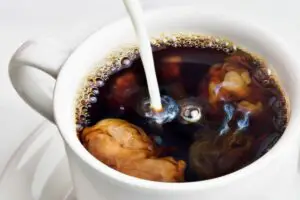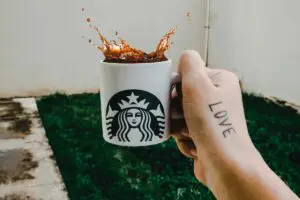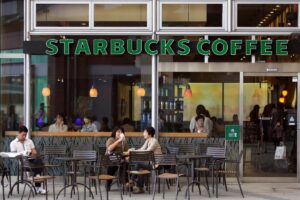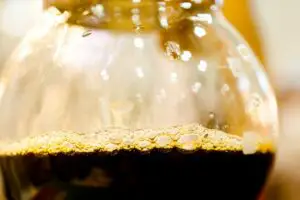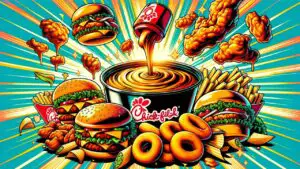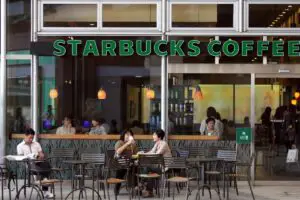Last updated on January 10th, 2025
*This post may contain affiliate links. As an Amazon Associate we earn from qualifying purchases.
Ah, Starbucks… The siren that lures us in, beckoning us to spend our money on overpriced, sugary concoctions served by cheerful baristas sporting green aprons, while we pretend to write the next great American novel at the coveted window seat.
All as our spouse manages the chaos of our three children (Jonathan, 8, who loves nothing more than to provoke his sisters; 5-year-old princess Clara, who carries around her stuffed unicorn Sir Fluffinsworth; and our know-it-all 12-year-old Mia) at home.
But is Starbucks real coffee? That’s the question on many a caffeinated mind.
Starbucks does have real coffee but many coffee aficionados shun the chain since they feel like it is just a glorified candy shop for adults (since most of their drinks contain such high amounts of sugar). But just because some stuck-up coffee connoisseurs say that your favorite macchiato or iced coffee with cold foam on top isn’t “real” doesn’t make it the truth.
Sure, Starbucks might not be the most authentic coffee and most people who order from there don’t drink it “black” but that doesn’t make it any less “real coffee” than a high-end specialty coffee club.
Coffee has seen me through countless late-night working and writing sessions – not to mention the usual parenting shenanigans. So assessing Starbucks’ coffee status and quality is not only a humorous inquiry but also an important one.
It affects our daily lives, relationships, and let’s not forget, our bank accounts. So buckle up, friends, for this caffeinated expedition into the world of Starbucks and its coffee credibility.
Key Takeaways:
- Starbucks takes pride in its coffee bean origins, sourcing beans from ethical and sustainable sources through programs like C.A.F.E. Practices and Farmer Support Centers.
- While Starbucks is known for its dark roasts, which some coffee snobs may criticize for sacrificing subtle flavors, many people appreciate the bold taste and find it satisfying.
- Starbucks offers a wide range of coffee preparations, including espresso-based beverages, brewed coffee, cold brew, and iced coffee, with consistency in taste and presentation across its numerous locations.
- The flavor profile of Starbucks coffee is bold, intense, and customizable, catering to a variety of tastes and preferences.
- While Starbucks may not fully align with the third-wave coffee movement, they have adapted by offering small-lot and single-origin coffees, showcasing unique brewing techniques, and incorporating some aspects of the movement into their offerings.
Defining “Real Coffee”
When it comes to reclaiming our sanity and surviving parenthood, real coffee is the nectar of the gods. But what do we mean by this elixir’s authenticity? And does Starbucks really serve it?
For our investigation, we’ll compare Starbucks’ products to the standards of traditional coffee in four categories:
- Bean origin
- Roasting process
- Drink preparation
- Flavor profile
Let’s dive in…
Coffee Bean Origins
Overview of Starbucks’ coffee bean sourcing
“I’ll take a grande bold coffee with an extra shot of Guatemalan beans, please! ” At Starbucks? You bet!
Starbucks takes pride in its coffee bean origins, building an extensive array of ethically sourced beans from around the world.
Ethical sourcing initiatives
Through the C.A.F.E. Practices program and Farmer Support Centers, Starbucks has established partnerships with farmers across the globe to make sure their beans come from ethical and sustainable sources. Check out their bean ethics in detail.
Bean variety and single-origin offerings
With an impressive selection of bean types and single-origin coffees, it’s tough to argue that these little brown morsels aren’t real coffee.
Comparison to traditional coffee bean sources
Compared to the strict sourcing of high-quality, independent coffee shops, Starbucks may seem like a large corporate behemoth. However, when it comes to bean origins, Starbucks goes the extra mile to ensure the little brown morsels that make up our daily java are as authentic as they come.
Starbucks’ Roasting Process
The roasting conundrum! The darkest secret of the coffee world… or rather, the darkly roasted secret. Starbucks is notoriously known for boldly roasting its beans to a near-burnt level.
For coffee aficionados, roasting is an essential factor in coffee’s overall taste profile. A single bean, roasted at varying levels, can yield entirely different flavors. So next time you’re struggling with parenthood decisions, remember that controlling the roast brings power to your cup!
While coffee snobs may argue that Starbucks’ dark roasts sacrifice subtle flavors, the truth is that many people appreciate the bold taste in their morning pick-me-up.
Comparing Starbucks’ roasts to the lighter methods of traditional coffee shops is like comparing steak preparations – it all boils down to personal preference.
While the bold roasts might not line up perfectly with the methods of traditional coffee shops, Starbucks knows its target audience, and there’s no shortage of fans seeking out that extra-bold kick to jolt them back to reality in the morning.
You won’t find the same nuanced flavors achieved by a boutique café, but Starbucks’ roasts are still very much real coffee.
Drink Preparation and Quality
Let’s be real – we all know that Starbucks is more akin to a dessert factory than a coffee shop when it comes to their expansive menu of unicorn frappuccinos, caramel macchiatos, and pumpkin spice lattes.
But fear not! They still serve espresso-based beverages, brewed coffee, cold brew, and iced coffee.
Consistency in preparation across Starbucks locations
While the purists may argue that Starbucks’ flavored concoctions and endless combinations lack the elite artistry of bespoke baristas, there is something to be said for consistency. Across thousands of locations around the world, Starbucks delivers uniformity in both taste and presentation.
Assessment of Starbucks baristas’ coffee-making skills
“Can that green-apron-clad barista REALLY make my coffee?” An essential question if we’re considering Starbucks’ coffee authenticity.
In reality, while some Starbucks baristas may lack the precision and artistry of their boutique counterparts, thousands of others take their coffee craftsmanship incredibly seriously. The result?
The experience of your drink may vary, but you’ll still get your caffeine fix.
Comparison to traditional coffee preparation methods
All that said, Starbucks’ drink preparation might not be as highly regarded as the dainty pour-over methods of more traditional coffee establishments, but they’ve managed to create a distinctive and reliable approach to coffee-making that has served them well – and kept us caffeinated!
Flavor Profile and Taste
Although Starbucks has catered to America’s love for dessert-like drinks, we cannot deny that their coffee possesses some hallmarks of real coffee characteristics – boldness, acidity, and mouthfeel.
With the astounding range of menu options, Starbucks caters to a wide variety of coffee drinkers – from the die-hard espresso fan to whimsical concoctions. Starbucks’ strength lies in its ability to customize drinks based on customer preference.
In terms of flavor profile, comparing Starbucks to a traditional coffee shop is somewhat like comparing apples and oranges. While traditional coffee shops may offer more subtlety and delicate notes, Starbucks focuses on a bolder, more intense profile.
In conclusion, with the varied options on Starbucks’ menu and the flexibility to cater to a wide variety of drinkers’ preferences and tastes, Starbucks’ offering is far more extensive and inclusive than that of a traditional coffee shop.
Starbucks and Third Wave Coffee Movement
In recent years, the so-called Third Wave Coffee Movement has emerged, with cafés focusing on coffee as an artisanal, almost spiritual experience. How does Starbucks, the world’s largest coffee chain, fit into this trend?
Starbucks’ role in this movement
While originally not part of the movement, Starbucks has adapted by offering small-lot and single-origin coffees, sourcing beans from celebrated regions, and even opening their Reserve Roastery locations to showcase unique brewing techniques and rare bean offerings.
Starbucks may not have the same level of handcrafted, micro-roasting finesse as some third-wave coffee shops, but they have made efforts to adapt and integrate some aspects of the movement into their offerings.
Impact on Starbucks’ “real coffee” status
Despite facing criticism from coffee purists, Starbucks’ inclusion of third-wave ideals in their Reserve Roastery locations and small-lot offerings helps establish that they strive to provide authentic, high-quality coffee options alongside their well-loved classics.
Health Benefits of Starbucks Coffee
When it comes to health benefits, Starbucks’ basic coffee offerings contain essential nutrients and antioxidants found in traditional coffee, making it a healthy choice for coffee drinkers.
Like any other coffee offering, Starbucks’ traditional coffee menu items share the same health perks, such as improved mental alertness and a reduced risk of certain diseases.
However, we cannot ignore that Starbucks’ lineup of sugary, high-calorie beverages aren’t the healthiest choices. Consumers seeking the health benefits of coffee should opt for black coffee or drinks with minimal added sugars.
Ultimately, Starbucks offers a variety of drinks to cater to different health preferences, but the health-conscious coffee drinker can certainly find “real coffee” options on the menu.
The Impact of Starbucks’ Brand Image
Beyond the coffee itself, there’s no denying that Starbucks’ brand image plays a vital role in shaping consumer perception of their coffee quality. The green mermaid logo has become a symbol of consistency, familiarity, and comfort for many coffee drinkers.
The role of marketing in promoting Starbucks coffee
Starbucks’ marketing strategies have contributed significantly to its global success. By positioning itself as an accessible and ubiquitous coffee destination, Starbucks has built a reputation for offering dependable, quality coffee products.
The Starbucks Experience and its effect on perceived coffee quality
The “Starbucks Experience” – free Wi-Fi, cozy seating, and a welcoming atmosphere – adds to customer perceptions of the authenticity of its coffee. This home-away-from-home vibe establishes trust in both the Starbucks brand and their coffee offerings.
While Starbucks may not have the intimate, cozy feel of a smaller, independent coffee shop, the company has successfully managed to create a distinctive and inviting atmosphere that contributes to the perception of Starbucks as a “real coffee” purveyor.
Critics’ and Consumers’ Opinions
As with any global brand, Starbucks faces praise and criticism from the masses. Public opinion spans from loyal Starbucks enthusiasts to critics who dismiss the company’s coffee offerings as sugary concoctions.
Critics argue that Starbucks’ flavored drinks, bold roasts, and corporate image detract from the authenticity and quality of its coffee offerings.
On the other hand, devoted Starbucks fans appreciate their menu offerings, applauding the company for delivering consistent quality, ambiance, and an ever-evolving selection of coffee specialties.
As public opinion over Starbucks’ coffee authenticity and quality is divided, the best way to assess its coffee offerings is to experience and taste it for oneself.
Conclusion
In summary, Starbucks has proven itself both a leader and an innovator in the world of coffee. They have demonstrated a commitment to ethical sourcing, quality beans, and catering to the preferences of their vast customer base.
While Starbucks may not satisfy the taste buds of every coffee purist out there, it undeniably offers a variety of “real coffee” options to cater to the masses. There is beauty in the diversity and adaptability of Starbucks’ offerings.
Starbucks has played a significant role in shaping the global coffee culture, providing accessibility and familiarity to millions of coffee drinkers worldwide.
Ultimately, the question of “Is Starbucks real coffee?” boils down to personal taste and preferences. No one can (or should) tell you what “real coffee” means to you. So go ahead, fellow coffee fiend – take a sip, savor, and decide for yourself!

